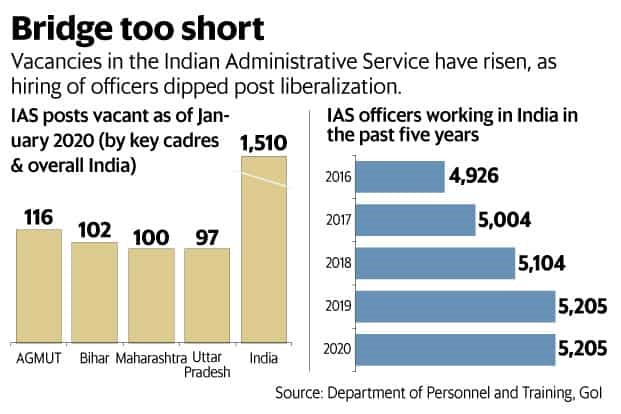LATERAL ENTRY INTO BUREAUCRACY
2021 MAR 3
Mains >
Governance > Role of Civil Services in a Democracy > Importance of Civil Services
IN NEWS:
- Recently, the Union Public Service Commission (UPSC) issued an advertisement seeking applications for three posts in central government Departments to be filled through lateral entry.
LATERAL ENTRY IN INDIA:
- In bureaucracy, lateral entry mode pertains to the appointment of specialists from private sector in government organisations.
- Lateral recruitment is aimed at achieving the twin objectives of bringing in fresh talent as well as augment the availability of manpower.
- These jobs would be contracted for three to five years.
- The government of India in 2018 had allowed lateral entry into empaneled bureaucracy by opening 10 joint secretary posts on a contractual basis.
- These ‘lateral entrants’ will be part of the central secretariat which, in the normal course, has only career bureaucrats from the All India and Central Civil Services.
HISTORY:
- In the past too, experts were inducted at senior positions into the government through lateral entry. Eg: The appointment of Dr. Manmohan Singh as RBI Governor in 1982.
- Scientific ministries, such as space or atomic energy, are less hierarchically organized and have allowed lateral entry of professionals more liberally.
- In 2005, the Second Administrative Reforms Commission recommended an institutionalized, transparent process for lateral entry at both the Central and state levels.
- In February 2017, both the NITI Aayog and the sectoral group of secretaries on governance have recommended induction of personnel in the middle and senior management level in the government.
RATIONALE BEHIND LATERAL ENTRY:
- Bridge vacancies: The vacancy in civil services is huge, primarily because India reduced hiring of IAS officers post liberalization. Currently, there is a shortage of 22.48% or 1,510 officers for the IAS cadre alone, according to official data. Lateral entry can help meet this shortfall.

- Brings in expertise: IAS officers lack the necessary domain knowledge, particularly in in subjects like civil aviation, defence, and shipping. Lateral entry can help bring in subject expertise and thus enhance bureaucratic productivity.
- Enhances work culture: Due to job security and lack of incentives for specialization, the ‘Permanent executive’ in India is increasingly becoming redundant and inefficient. Lateral entry can help in bringing the values of economy, efficiency and effectiveness into this situation.
- Break politician-bureaucratic nexus: As cited by the Vohra committee, the nexus between the bureaucracy and politicians has come out clearly in various parts of the country. Also, the Indian bureaucracy is a powerful lobby within the governance system, which has resulted in being corrupt and inefficient. Lateral entry can help break this nexus.
- Does not affect career prospects: Lateral entry recruitments are nominal compared to the total strength of the civil services. So, lateral entry would not cause much insecurity in the minds of the directly recruited career bureaucrats that it would minimize their scope for promotion.
- Aligns with contemporary trends: The generalist Civil Services was designed for a time when the State was all-powerful. After the 1991 liberalization, markets are playing critical role in administration. Hence it makes more sense to make lateral entry from private sector.
CONCERNS:
- Selection process: The current mode of evaluation of lateral entry candidates does not inspire confidence about its fairness and transparency.
- The criteria laid out in the advertisement were broad-based.
- Most of it is done by the Department of Personnel and Training or the concerned departments and not the UPSC.
- It is highly doubtful if the domain expertise and aptitude of the potential candidates can be assessed properly through an examination or interview lasting a few minutes.
- Conflicting organizational value: The basic objective of Private sector is profit oriented while that of the government is public service. Hence, the entrants need to be undergone a fundamental transition, which is difficult given their short-term contract.
- Potential conflict of interest: Through lateral entry, Individuals who worked in corporate houses are put to the seat of power from where they can formulate norms and controls. After the government stint, they will go back to the industry and enjoy those same rules that they formulated. Thus, their impartiality may be questioned.
- Bypasses reservations: The lateral entry system does not provide for reservation in these appointments for SCs, STs and OBCs.
- Internal resistance: It will be difficult for a handful of lateral entrants hired on a contractual basis to make any real interventions in governance when the system continues to be dominated by the traditional IAS officers.
WAY FORWARD:
Recruiting from the open market is not enough to radically professionalize the civil service. Professionalizing the existing cadre of officers requires greater attention. This can include reforms such as:
- Promoting internal specialization: Governments should incentive civil servants to acquire knowledge or improve their skills. For instance, IAS officers should be encouraged to specialise in one or two chosen sectors by giving them long tenures and permitting them to join academic or research organisations where they could improve their intellectual skills.
- Ensuring tenure security: Civil servants should be provided with minimum tenure security so that they do not succumb to political pressure. This can help reduce the nexus between bureaucracy and politicians.
- Performance review mechanism: Comprehensive performance evaluation systems need to be developed to identify underperforming officers.
- Rationalization of services: At present, there exists over 60 separate civil services at the central and state level. This needs to be reduced and uniformity should be ensured in the system.
- Institutionalize lateral entry: Lateral entry on an ad hoc basis it cannot be considered a suitable model of manpower planning. There is a need to institutionalize the process of induction of outside talent into the government.
PRACTICE QUESTION:
Q. Lateral entry into bureaucracy has its merits, but it is not a panacea for the ills plaguing the administrative system. Examine?
